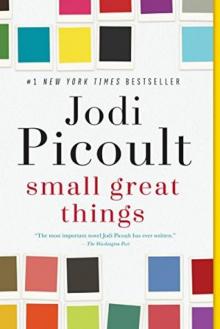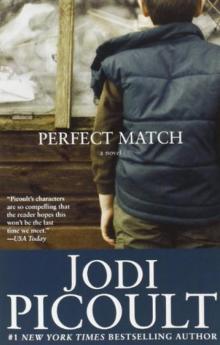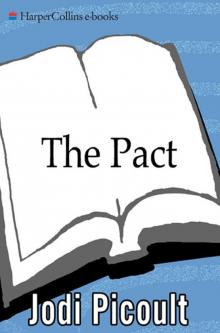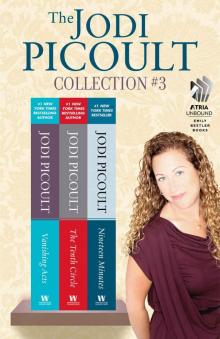- Home
- Jodi Picoult
The Book of Two Ways Page 3
The Book of Two Ways Read online
Page 3
Asshole.
There were legacies at U Chicago, but at Yale, they seemed to be the norm instead of the exception. I hadn’t been here very long, but the few students I’d met seemed to be ripped from the pages of Town & Country. My roommate, whom I’d found through a flyer on a bulletin board, came from the Hudson Valley and was obsessed with dressage. I assumed that had something to do with fashion, until I saw her in her horseback riding gear.
Suddenly the guy looked up, his blue eyes catching mine. They made me think of the heart of a glacier, of how, when you touch dry ice with your bare skin, you cannot let go even if you try.
He opened his mouth, and let out a long, low burp.
Disgusted, I turned away as the bartender put a napkin down in front of me. “What can I get you?” she asked.
On my budget, I couldn’t afford a drink, but I also couldn’t wait out the rain without ordering something. “Soda water?”
“She’ll have Hendrick’s, straight up. Twist of lime.” The guy had moved to take the seat beside me, so seamlessly and silently I hadn’t noticed.
The first thing that surprised me was his accent—British. The second was his utter arrogance. “No thanks.”
“It’s on me,” he said. “And I’m usually quite good at guessing someone’s signature drink.” He nodded at a girl in a sequined bustier who was dancing by herself. “Skinny margarita or, God forbid, a rosé spritzer.” Then he gestured to two men in matching motorcycle leather making out. “Fireball whisky.” He pointed to me. “Martini. Did I get it wrong?”
I did prefer gin, but I would have rather died than admit that to him.
“My mistake: three blue cheese olives,” he called to the bartender, and then he turned to me again. “You’re a savory sort of woman, aren’t you.” A grin ghosted over his lips. “Or perhaps you’re unsavory.”
That was enough. Even if the rain and wind had reached hurricane force, it had to be less painful than sitting next to this conceited moron. I reached for my stack of books, but he plucked one from the top and opened it, skimming the hieroglyphs.
“Egyptology. I didn’t see that coming.” He handed me back the book. “Are you an ancient artifact of cultural significance?” he murmured, leaning a fraction closer. “Because I dig you.”
I blinked. “Does that line actually ever work?”
“Fifty-fifty,” he said. “I have a backup. How about I’ll be the cultural relativist and you assume the missionary position?”
“I’m glad you’re into history, because that’s what you’re about to be.” I took a long sip of the martini and hopped off the barstool. “Thanks for the drink.”
“Wait.” He touched my arm. “Let me start over without the BS. I’m Wyatt.”
“Liar.”
“I beg your pardon?”
“Your friends called you Mark.”
“Ah, that’s a nickname, short for the Marquess of Atherton.”
“You’re a marquess?”
“Well, no.” He hesitated. “The marquess is my father. I’m merely an earl.” He lifted his glass to mine, clinking the rim. “English through and through, all the way back to William the Conqueror, I’m afraid, and inbred ever since.” He flashed a smile then, a real one, as if letting me in on a joke. Suddenly I understood how he had gotten to be such an entitled dick. It had nothing to do with being an earl. It was that when he smiled—wide and almost apologetic—people probably fell all over themselves.
“So,” he said. “You are…?”
I set my glass down on the bar. “Leaving,” I replied.
* * *
—
THE NEXT MORNING, I was the first one in the small seminar room where Ian Dumphries, the head of Egyptology at Yale, had invited all of this year’s graduate students to kick off the academic year. I’d already met him during interviews when I was applying to the doctorate program. Unlike many other Egyptologists, he didn’t focus only on one narrow facet of the discipline, such as mud brick architecture or the battle of Kadesh or Egyptian grammar. He published widely about all sorts of topics: the Book of Two Ways, Middle Kingdom archaeology, the history of Egyptian religion, and even an occasional demotic ostracon. Given what I hoped to write for my dissertation, I wanted a mentor who was open-minded. I found Dumphries utterly brilliant and equally terrifying, so I was surprised when he greeted me by name. “McDowell,” he said. “Welcome to Yale.”
The biggest reason I had come to this university was because I knew that here I would get to work at Deir el-Bersha. Back in the 1890s, the necropolis had been the domain of a British Egyptologist, Percy E. Newberry, who worked with Howard Carter (of later Tutankhamun fame). The oversight of it had changed hands many times before 1998, when Yale acquired the concession, which was supervised by Professor Dumphries.
Five more graduate students entered, tangled in a messy knot of conversation. There were only seven of us in the entire department at Yale, which had been another selling point for me. They sat down at the seminar table, chatting with an easy familiarity. I was the only new doctoral candidate this year.
“Good to see you’ve all survived another summer,” Dumphries said. “I’d like to introduce our newest sacrifice, Dawn McDowell. We’ve poached her from Chicago. Why don’t you all give her a thumbnail introduction of who you are and how you got here?”
The roots of my curiosity absorbed the schools they’d studied at, their dissertation topics. Just as the last student was wrapping up, the door burst open. Wyatt Armstrong strode in, balancing a box of Dunkin’ Donuts coffee and another of Munchkins. “Sorry I’m late. It’s a long and sordid story involving a cement mixer, a crying infant, and a Komodo dragon, but instead of boring you with all that I come bearing conciliatory pastries and mediocre coffee.”
I stared, my heart pounding, calculating the odds. In a school with 7500 graduate students, how could I possibly wind up in a tiny department with the one person I’d hoped to never see again?
I wondered how Dumphries, starched and buttoned up as he was, would react, but he just shook his head and smiled slightly. “Sit down, Wyatt,” he said, in the tone an exasperated parent saves for the child who drives him crazy, but whom he secretly loves beyond reason. “You’re just in time to tell Ms. McDowell who you are and why I keep you around.”
Wyatt slid into the empty chair next to mine. If he was surprised when he saw my face, he didn’t show it. “Well, hello, Olive,” he drawled.
“It’s Dawn.”
He raised a brow. “Is it,” he murmured. “I studied Egyptology at Cambridge and came here three years ago. I’m a linguistics wonk so I TA in all the undergrad classes on hieroglyphs, hieratic, and demotic. My thesis title is ‘Ritual Speech and Interlocutory Verbal Patterns in the Coffin Texts.’ I spent six months coming up with something that sexy, so don’t go stealing it.”
“The Coffin Texts?” I repeated.
“Dawn plans to study the Book of Two Ways,” Dumphries interjected.
Wyatt pinned his gaze on me. “Guess you and I are going to be all up in each other’s business.”
“I’m not a philologist,” I qualified. “I’m just trying to fill in a gap in the research.” I turned to the other grad students, offering context. “Pierre Lacau published the text from the Book of Two Ways coffins in Cairo in 1904 and 1906, but most of the coffins have never been published as coffins.” Now that I was warming up to my favorite subject, my words came faster. “I want to write about the iconography. You can’t just look at the map of the Book of Two Ways without thinking of the coffin as a microcosm of the universe. Imagine the front side of the coffin is the eastern horizon. The back side is the western horizon. The floor is the Netherworld, with its map. The lid is Nut, the sky goddess, and going into the coffin is like going back into her womb—getting reborn from the coffin to the afterlife. The mummy fills all the space between he
aven and earth.”
Dumphries nods. “So Wyatt’s thesis will be a new translation of the Book of Two Ways. And Dawn’s thesis will collect all the illustrated representations of the Book of Two Ways for the first time.”
One of the other students smirked. “You guys should publish as a matched set.”
“Funny you should mention that,” Dumphries said. “Dawn’s too humble to tell you herself, but she already published a chapter of her dissertation in the Journal of the American Research Center in Egypt.”
I blushed. It was nearly unheard of for an undergrad’s work to be accepted by a journal of Egyptology; I knew that was in part why Yale had wanted me. I was fiercely proud of it. “It was called ‘The Corpse Makes the Coffin Whole,’ ” I added.
Feeling the heat of Wyatt’s gaze, I turned. “That was yours?” he said.
“You read it?”
He jerked his head, a tight nod. He glanced at Dumphries—so effusive in his praise for me—his lock on teacher’s pet suddenly less solid. Something shuttered in Wyatt Armstrong at that moment, armor sliding into place.
* * *
—
FOR THE NEXT month, Wyatt and I did an excellent job of avoiding each other unless we were forced to interact, which happened Mondays and Wednesdays at 9:15 when we both TA’d sixteen undergrads in Dumphries’s course Gods of Ancient Egypt. Even then, we sat on opposite sides of the seminar table. Then, in October, we were told that we would be accompanying Dumphries and the class on a field trip to the Boston Museum of Fine Arts to see the new exhibit on the Book of Two Ways.
I had only seen the map of the Netherworld in books. Nothing was going to spoil the excitement I felt at being so close to an image of the Book of Two Ways. Not even Wyatt.
The day of the trip, Dumphries stood in the front of a classroom in the museum, clicking through a series of excavation slides from Deir el-Bersha. “Imagine it’s 1915,” he began, “and you’re an Egyptologist who’s found a thirty-foot burial shaft under a pile of boulders in a necropolis from the Middle Kingdom. You’ve cleared the debris, and you’ve just crawled into Tomb 10A for the first time. You let your eyes adjust to the darkness and what do you see? A coffin, with the decapitated head of a mummy sitting on top of it.”
A student in front of me shook his head. “Fucking Indiana Jones shit, man.”
Beside me, Wyatt snorted.
“Tomb 10A belonged to a nomarch named Djehutynakht, and his wife, also named Djehutynakht.”
Wyatt leaned toward me. “Imagine how confusing sorting the post must have been,” he murmured.
“They lived around 2000 B.C.E., in the Middle Kingdom, and ruled one of the provinces of Upper Egypt. Sometime in the four thousand years between their death and the early twentieth century, grave robbers broke into the tomb, stole the gold and the jewels and all the valuables, and threw the headless mummy into the corner. Then they set fire to the chamber, so they didn’t leave any evidence behind. But some of the material in the tomb survived and was brought to the MFA by Harvard Egyptologists in 1921. This is the first time it’s been exhibited.”
I stared at the slide on the screen: the mummy head, wrapped in its frayed linen, brown with ancient resin. It had hand-painted eyebrows and slightly bulging eye sockets. Its mouth turned down, as if it were mildly disappointed.
An undergrad raised her hand. “Where’s the rest of him?”
“Egypt,” Dumphries replied. “But is it the rest of him? Or her? Amazing to think that we’ve had four thousand years to figure this out, and we still don’t have all the answers.” He flipped to the next slide. “The evolution of the Coffin Texts and the Book of Two Ways was more about changing tastes in funerary decoration than it was about more people having access to the blessed afterlife. As coffins became more common in the Middle Kingdom, those spells that used to be on precious papyri could now be painted on the wood of the coffin.”
He clicked again, and the slide became the familiar image of the Book of Two Ways, its snaking blue and black lines and the red lake of fire that kept them from crossing.
PHOTOGRAPH © 2020 MUSEUM OF FINE ARTS, BOSTON
“The Book of Two Ways is yet another confirmation of the unity between Re and Osiris,” Dumphries explained. “The main purpose of Re’s journey through the Netherworld is to unite with the corpse of Osiris. The roads through the Netherworld are for Re to travel to reach Osiris. The goal of the deceased is to become both Re and Osiris, in order to attain eternal life.”
He traced a finger over the wavy lines on the projected image. “Mind you, the Book of Two Ways doesn’t actually mention two ways. Just…ways. The black and blue roads are not labeled directly, but we can imagine them as a land and a water route to the Netherworld that lead to the same outcome.”
Dumphries glanced around the room, and I realized he was looking for me. “McDowell,” he said. “Tell us what the key to resurrection was, according to the Book of Two Ways.”
“Knowledge,” I said, straightening. “That’s why the texts were placed in the coffin. They’re spells the deceased has to have in order to pass all the obstacles en route to the shrine of Osiris.”
“Exactly. And frankly, who doesn’t need knowledge to survive tests in this world…or the next?” He faced the students. “Questions?”
A student raised his hand. “Will this be on the midterm?”
Dumphries flicked his eyes away, dismissive. “Next?”
“Did you have to be super rich to have the Book of Two Ways painted in your coffin?” another student asked.
“The ones we’ve found at Bersha have come from nobles of the Hare nome, but a good death wasn’t linked to economic status. Every Egyptian could become an akh—a transfigured soul.”
A third student raised her hand. “What about gender? Did women get the map, too?”
“Yes,” Dumphries said. “It’s been found in the tombs of noblewomen.”
Wyatt crossed his arms. “There are some Egyptologists who claim that women had to take on male characteristics to become an Osiris, much like a female pharaoh would wear the ritual false beard of the king.”
“I doubt it,” I said. “The word corpse in Ancient Egyptian is already feminine. And there’s a woman’s Middle Kingdom coffin where the spells have pronouns that were all changed from male to female, tailored to the deceased.”
Wyatt and I stared at each other, facing off, as Dumphries shut the projector. “If Mommy and Daddy are done arguing,” he said drily, “we’re going to turn you loose in the museum. Armstrong, McDowell, I pass you the torch.”
While Dumphries left with the museum curator to look at objects from Bersha that weren’t on display, Wyatt and I herded the undergrads through the MFA. He was the primary TA; even if I’d wanted that position I wasn’t as adept at teaching hieroglyphs. I had to admit, he was good at it.
Wyatt gathered the undergrads in a semicircle at the doorway of the new exhibit. The undergrads held packets with hieroglyphs that had been copied from the coffins they were about to see firsthand. The girls, and some of the guys, were gazing at Wyatt as if he had just created the cosmos. I knew that there were undergrads who signed up for Dumphries’s courses because of the British TA who, if you believed the gossip, was apparently Harrison Ford and the Second Coming all rolled into one.
“We tend to think of literacy in Ancient Egypt as black and white—either you could read or you couldn’t. In antiquity, it was actually a continuum. If you were a priest or a bureaucrat, you’d learn hieroglyphs. If you were training to be a scribe, you learned hieratic—the cursive form of hieroglyphics—for everyday use in contracts and wills and village documents. But even if you were in the public, you could still recognize basic symbols, the way we’d know a stop sign by its shape even if we couldn’t read the letters on it. All of you are going to hopefully achieve the reading le
vel of a bureaucrat. Let’s get to it, then.”
The Ancient Egyptians can be credited with developing our alphabet. When early Semitic speakers traveled from what’s now Israel to Egypt, they didn’t have a writing system. They saw the Egyptians writing their names on rock and wanted to do it, too. So they picked hieroglyphs that represented common objects—water, an eye, a bull’s head—and used them to form the first letters of those words in their own language.
Wyatt walked into the exhibit, stopping in front of a case that had the exterior panel of Djehutynakht’s coffin. I scanned the columns of hieroglyphs painted on the ancient cedar, looking for the owner’s name.
The ibis stood for Djehuty—the ancient Egyptian name of the god Thoth. The squiggle was a line of water, the letter n. The stick beneath was khet. The circle with the horizontal lines were kh—repeating the sounds of the stick—and the loaf was t. When you translate hieroglyphs, you do it in two steps, the first of which renders the sounds of the hieroglyphs into a script that uses alphabetic signs. So the transliteration was —
“Djehutynakht’s coffin,” Wyatt announced. “What’s the first thing we need to figure out?”
“Which way the faces point in the signs,” a girl answered. “Because you read toward the faces.”
“Right. So in this case, the bird faces left, which means…?” He glanced at the girl.
“We’re reading the columns of text from left to right.”
“Exactly. Now, one of the reasons it took so long to decipher hieroglyphs is because they’re not purely phonetic or purely ideographic. It’s a mixture, with an additional sign type thrown in just to confuse you further—a determinative. Determinatives are like clues to give you information about the meanings of the words near them.”
The students crowded closer, squinting at the images on the exterior of Djehutynakht’s coffin. They were greenish blue, some standing out in stark relief against the strip of eggshell paint, others so faint they could barely be distinguished from the grain of the wood. “Who can find an ideogram?” Wyatt asked.

 Small Great Things
Small Great Things Leaving Time
Leaving Time Nineteen Minutes
Nineteen Minutes Larger Than Life
Larger Than Life Perfect Match
Perfect Match My Sister's Keeper
My Sister's Keeper The Pact
The Pact Handle With Care
Handle With Care Songs of the Humpback Whale
Songs of the Humpback Whale Mermaid
Mermaid The Tenth Circle
The Tenth Circle The Color War
The Color War Leaving Home: Short Pieces
Leaving Home: Short Pieces House Rules
House Rules Lone Wolf
Lone Wolf The Storyteller
The Storyteller The Book of Two Ways
The Book of Two Ways Shine
Shine Off the Page
Off the Page Sing You Home
Sing You Home Second Glance: A Novel
Second Glance: A Novel Mercy
Mercy Vanishing Acts
Vanishing Acts Between the Lines
Between the Lines Plain Truth
Plain Truth Salem Falls
Salem Falls Keeping Faith
Keeping Faith Harvesting the Heart
Harvesting the Heart Change of Heart
Change of Heart Where There's Smoke
Where There's Smoke Leaving Time: A Novel
Leaving Time: A Novel Over the Moon
Over the Moon House Rules: A Novel
House Rules: A Novel The Jodi Picoult Collection #2
The Jodi Picoult Collection #2 Leaving Home: Short Pieces (Kindle Single)
Leaving Home: Short Pieces (Kindle Single) My Sister's Keeper: A Novel
My Sister's Keeper: A Novel![Mermaid [Kindle in Motion] (Kindle Single) Read online](http://i1.bookreadfree.com/i1/04/03/mermaid_kindle_in_motion_kindle_single_preview.jpg) Mermaid [Kindle in Motion] (Kindle Single)
Mermaid [Kindle in Motion] (Kindle Single) The Jodi Picoult Collection #4
The Jodi Picoult Collection #4 Sing You Home: A Novel
Sing You Home: A Novel The Jodi Picoult Collection
The Jodi Picoult Collection Lone Wolf A Novel
Lone Wolf A Novel Second Glance
Second Glance Larger Than Life (Novella)
Larger Than Life (Novella) The Jodi Picoult Collection #3
The Jodi Picoult Collection #3